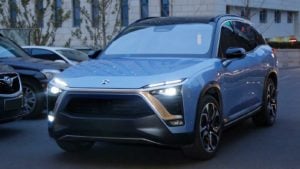Shanghai-based Nio (NYSE:NIO) is expected to report its third-quarter earnings on Dec 30. The company announced the date after a recent rally by Nio stock and weeks of delay and speculation as to what may be happening with the company behind the scenes.

U.S.-based, publicly traded companies are required to file their quarterly 10-Q within 45 days of the end of their quarters. However, in the U.S., Nio stock is traded through American Depositary Receipts (ADR). Therefore, the filing requirement does not apply to NIO.
Over the past year, Nio stock price is down over 60%. It is currently hovering around $2.45. I would not yet be willing to commit any new capital to Nio stock, at least not before analyzing the company’s Q3 results.
In the near future, I would not be surprised if Nio is acquired or if the company gets a rescue package of some sort. But Nio stock price may have to drop further before either of those events, especially an acquisition, occur.
Nio’s Q2 Results Were Not Impressive
As a designer of premium electric vehicles (EVs), NIO is closely followed. At times, it has been touted as the Tesla (NASDAQ:TSLA) of China.
Nio currently sells cars exclusively in China. Its main model is the ES8 (a seven-seater SUV). In addition to the ES8, the company has two other vehicles, the EP9 ( a two-seater sports car) and the ES6 (a five-seater SUV).
On Sept. 24, the company released weak Q2 results. Its quarterly net loss was $479 million, or 47 cents per share, while its revenue came in at $206 million. It generated $206 million from vehicle sales, a decrease of 7.9% versus Q1.
The Fundamentals of NIO Stock Are Worrisome
Nio burned about $500 million in Q2, and its cash burn rate is not likely to decrease any time soon. As of Mar. 31, Nio had $1.123 billion of cash and equivalents. By the end of June, that number had fallen to $503.4 million.
Many analysts are now expecting Nio to run out of cash in early 2020.
The company’s gross margin is also still negative. Nio’s negative gross margins and high cash burn rate are two of the most important issues for Nio stock.
NIO sells cars for less than what it pays to manufacture them. The Street is wondering how much longer that situation can go on.
In November, Nio delivered 2,528 vehicles, in-line with estimates. Although the deliveries met expectations, the company may not be able to keep operating with negative margins for much longer.
In 2019, investors became skeptical of many IPOs. Maybe it is time to admit that the IPO of Nio stock was based on its potential and hype, rather than its financial performance.
2019 Has Been a Difficult Year for NIO Stock
When NIO was founded in 2014, its initial backers included Baidu (NASDAQ:BIDU), Tencent (OTCMKTS:TCEHY), and Singapore’s sovereign wealth fund, Temasek Holdings. In China, consumers have generally been pleased with Nio’s vehicles.
However, from an investment perspective, the company has been risky and unpredictable.
After reaching an all-time high of $13.80 within two days of its IPO in September 2018, Nio stock price has declined. A number of factors have caused the drop of Nio stock price.
In early 2019, management started the year by cancelling a proposed factory where it was supposed to have manufactured its own cars. Then in June, Nio had to recall 5,000 of its ES8 SUVs due to battery fires.
By August, the company had to eliminate around 1,000 jobs as part of its restructuring efforts. It is currently laying off additional employees who are based in Silicon Valley.
In late October, Nio’s then-CFO resigned. His unexpected departure was followed by the sudden resignation of its Vice President of Finance in early November. After these two high-level executives in charge of the company’s financial operations resigned, I became more concerned about Nio stock.
As the EV industry has grown in China, the sector has become more competitive. There are currently over 500 Chinese EV manufacturers.
Analysts are debating how many of these companies can survive, especially now that various government subsidies for EVs have been considerably lowered.
In late September, Sanford C. Bernstein analyst Robin Zhu cut the firm’s price target on NIO stock to just 90 cents.
The Bottom Line on NIO Stock
In November and much of December, the Nio stock price surged. The company announced it would partner with chip giant Intel (NASDAQ:INTC) to develop driverless cars And many investors became encouraged by the stock’s rapid rally.
However, I believe it is still too soon to invest a great deal in Nio stock. From a financial perspective, I am concerned about the future of the company.
Nio stock’s decline since its IPO is a clear reflection of investors’ sentiment and major fundamental worries. Nio is a young company with unproven management. And the listing of its stock in a third country, i.e., the U.S., where it doesn’t sell any cars may have been premature.
It may not be an exaggeration to conclude that the company’s future is hanging by a thread.
However, I do not think that its major investors, including Tencent and the Chinese government, will allow the company to go under.
Thus, NIO stock is definitely a very high-risk bet, but I would not write it off just yet. Let’s first study its upcoming results before throwing in the towel fully.
Investors who are interested in investing in Chinese or clean energy companies, but do not want to commit a great deal of capital to NIO, may also consider investing in various exchange-traded Funds (ETFs) that own NIO, including iShares MSCI China ETF (NASDAQ:MCHI), Global X MSCI China Consumer Discretionary ETF (NYSEARCA:CHIQ), Invesco WilderHill Clean Energy ETF (NYSEARCA:PBW), and iShares Core MSCI Emerging Markets ETF (NYSEARCA:IEMG).
As of this writing, the author did not hold a position in any of the aforementioned securities.
